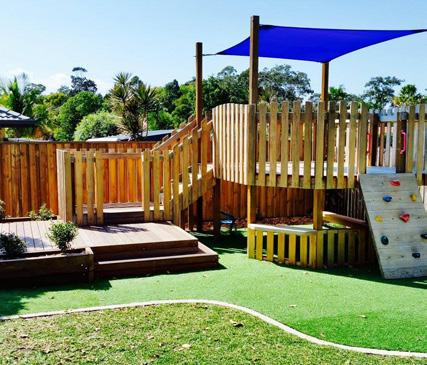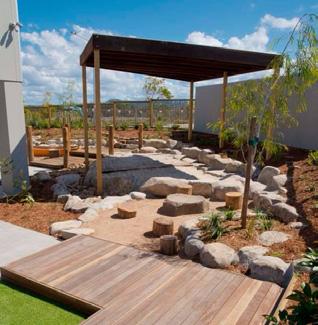
7 minute read
Modernising the humble backyard cubbyHOME
CUBBY LOVE
The recent restrictions have led to a revival of the humble backyard cubby. But what goes into creating a modern, eco-friendly nature play space?
Thanks to COVID-19, the backyard play space has had a huge resurgence. In the last few months, many families have introduced cubbies, nature play spaces and climbing equipment to their outdoor living, providing kids with an essential space to explore, imagine and play at home.
“We’ve found that we had an increase in cubbies and domestic backyards, since COVID-19 hit,” says George Davidson from GDL Nature Play Spaces. “Whether it's a tree house on acreage, or a small cubby in the city, families are now more focused on creating a play space at home.”
But what is it about the humble backyard cubby that kids love so much?
“A cubby is their own little place, somewhere different from their bedroom,” says George. “They can hide in there, make it into what they really want to, they can let their imagination run wild.”
With no electronics and the fact that kids can make a mess without a worry, parents love them too. However, forget the 1990’s plastic play house. The cubby of 2020 is sustainable, aesthetically designed and comes with plenty of blended nature play options.
“Our cubbies and play areas are all nature based,” explains George. “We use rustic timbers, natural shapes, and materials that are in harmony with the area.”
“Coming from a landscaping background we integrate the play area as an entire space, with corners to explore and sensory paths that connect various nooks, so everything flows. We use trees for shade, natural elements for climbing, so the cubby or play space blends seamlessly into the backyard.”
“Rather than off the shelf designs, we build to the area, to ensure we create a backyard play space that is aesthetically appealing, that adds value to the property, and will grow and change with the children as they get bigger, so the family gets value for money from the build.”
“Sometimes it’s not a cubby, it might


Combine gross motor skills with
just be adding in a few balance items, some sensory areas, or setting up a veggie garden. It’s the blend of landscaping, nature play and exploration that I think makes a truly imaginative play Credit: Flipside Circus successful outdoor play space.”
PLAY ON A BIGGER SCALE GDL play spaces are popping up all over Southeast Queensland, with many daycares and primary schools utilising the blend of landscaping and nature play to create the perfect outdoor space for kids at school.
“We recently put in a nature play space at Sunshine Beach State School,” explains George. “The school had an unused area next to their permaculture garden and their bush kindy, so they wanted something with a natural setting to link in with the existing bush kindy setup.”
The redeveloped space included a creek bed to teach kids about conservation, a nature play space and balance feature. As well as being a wonderful space for the bush kindy, the school also utilises it for education purposes, with the Preps and early primary classes using it as part of their outdoor education.
“The space is used for imaginative play, story time, gross motor skills, playgroup, and a meeting place for parents to sit and connect,” explains Maree Thomson from Sunshine Beach State School. “We specifically wanted a nature play space to connect the children with nature, and flow into our permaculture garden. It’s a wonderful


Rustic timbers and natural elements work in harmony with the area




space for their wellbeing, creativity and imagination, plus including the indigenous perspective with the yarning circle.”
“The kids love the water riverbed, stepping logs, weaving in and out of the tree trunks and playing in the tepee. With so many areas that lead to imaginative play, it’s wonderful to watch them enjoy it!” says Maree.
“We love that the kids can get wet and use the riverbed to float boats and problem solve when building dams. The yarning circle is also a lovely place to read stories.”
“It wasn’t a big project, but just by coming into a space, changing levels and adding certain features, we can make a huge difference,” says George. “Simple things such as how grasses are positioned can create flow in a natural space, so we feel it's important to focus heavily on the plants, choosing plants that will really make the space work and that will grow and morph the space over time.”
“As our spaces are becoming more popular across the whole of Southeast Queensland, we are also now expanding our services for both commercial and domestic builds where we design the playspace and construct any features – such as balance structures, teepees, cubbies – then deliver everything flat-packed, saving the customer the cost of us coming out to install. As a one-stop shop we can do everything as one project.” To find out more about GDL nature play spaces, visit gdlnatureplayspaces.com.au
FAMILY LAW & FAMILY PETS

Whether they’re furry, feathery or otherwise, pets provide fun, joy and companionship for the whole family. But what happens to the family pet following separation?
The emotional attachment with our pets means we think of them as family members rather than as mere possessions. Unfortunately, though, the law in Australia does not reflect this sentiment. !e Family Law Act deals with pets as personal property, in the same way it deals with other personal property like cars and furniture. !is means the family pet will be kept by one person and there is no provision for pet custody arrangements, unless an agreement for this can be reached.
Although pets are considered as personal property, normally they are not assigned a monetary value like other assets. However, in certain situations where a pet has a pedigree or where a pet is used for breeding or competition, a financial value may be assigned. !is was the situation in a case called Walmsely & Walmsley. !e Court held that the pedigree pets were worth $3,000. !e wife retained the pets and they were counted as an asset retained by her.
It is always best for separating couples to try to reach an agreement about who will retain the family pet rather than resorting to legal proceedings. In making appropriate arrangements for the pet, consideration should be given to the following: • which person has the most suitable living arrangements and lifestyle to accommodate the pet • the bond between the pet and the children and how this can be best maintained • who has the financial means to meet the ongoing costs of maintaining the pet. If an agreement can’t be reached about arrangements for the pet and a Judge decides who will retain the pet, a range of factors will be considered including: when was the pet purchased who purchased the pet and the circumstances of the purchase, for example was it a gift to one of the parties who is the registered owner of the pet who was the main carer for the pet during the relationship, for example, who fed the pet, took them for walks and took them to the vet who was responsible financially for the pet who has been caring for the pet since separation who has the best ongoing capacity to care for the pet, considering living arrangements, lifestyle and financial means the bond between the pets and the children how the pet arrangements impact the separation broadly.
BY JOANNE AUYEUNG AND CAROLYN DEVRIES, NEW WAY LAWYERS The above information is intended to provide general information about how family pets are treated in family law matters and does not represent legal advice. If you would like legal advice about family law matters, please call New Way Lawyers on 07 3548 5868 or visit www.newwaylawyers.com.au.










